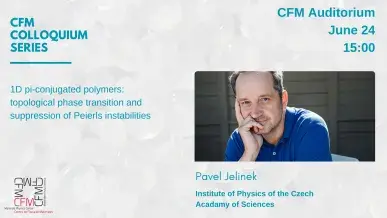1D pi-conjugated polymers: topological phase transition and suppression of Peierls instabilities
Pavel Jelinek
Institute of Physics of the Czech Acadamy of Sciences
CFM Auditorium
Andres Arnau Pino

CFM COLLOQUIUM SERIES
Recent progress in on-surface chemistry has enabled the synthesis and characterization of novel p-conjugated carbon molecular systems with unprecedented properties. This route, complemented with high-resolution scanning probe imaging (SPM), provides new opportunities to understand in detail their chemical and physical properties, including the emergence of magnetism in such materials.
In the first part, I will discuss the topological phase transition in acene ethynylene-bridged polymers, revealing a direct connection between topology and p-conjugation [1]. I will show that the quantum phase transition is defined by the length of the polymer, triggering the transition from a topologically trivial to a non-trivial phase above a certain polymer length [2]. Furthermore, I will introduce an experimental protocol that enables us to precisely control the quantum phase of the π-conjugated polymer via a highly selective hydrogenation process of the polymer and subsequent atomic-scale manipulation. I will also demonstrate that the pseudo Jahn-Teller effect is the driving mechanism responsible for the quantum phase transition. I’ll also discuss the interaction of edge states between two topologically non-trivial polymers [3].
In the second part, I will briefly review the Peierls transition, a fundamental concept in condensed matter physics, which predicts that a one-dimensional metallic chain must undergo a metal-to-insulator transition via lattice distortion. I will show that the Peierls transition can be globally suppressed by employing topology engineering of classic trans-polyacetylene chains connected to open-shell nanographene terminals with sublattice imbalance.
[1] B. Cierra et al, Nature Nano, 15, 437 (2020)
[2] H. Gonzalez-Herroro et al Adv. Mat. 33, 2104495 (2021)
[3] A. Jimenez et al, ACS Nano 18, 29902 (2024)
